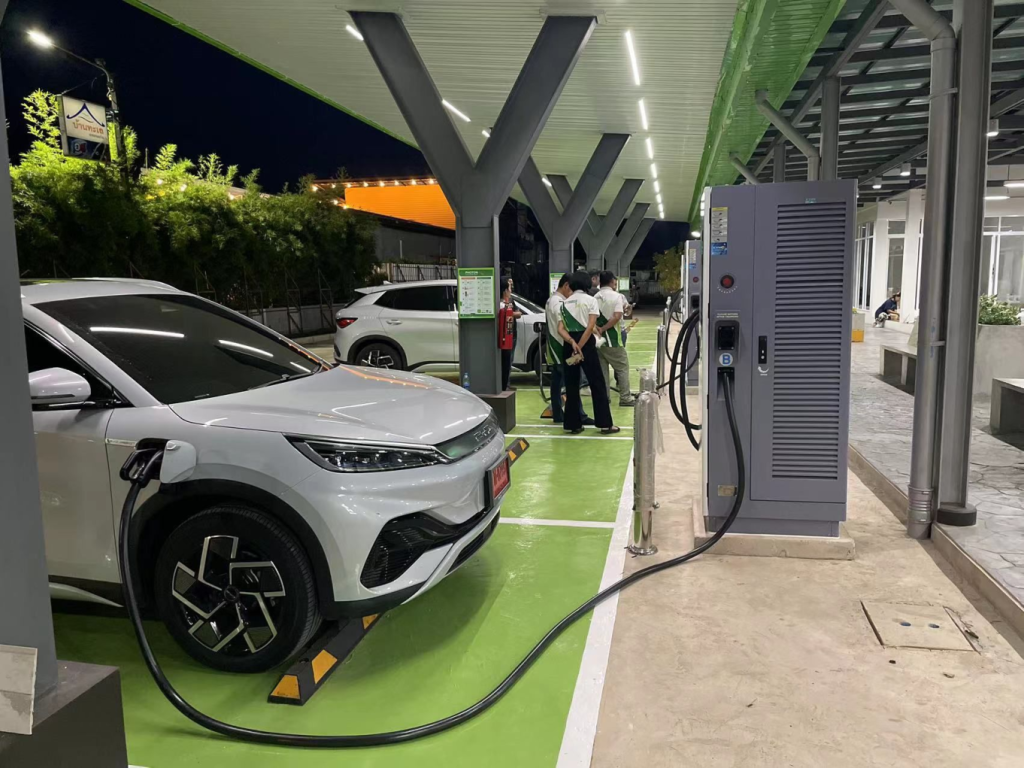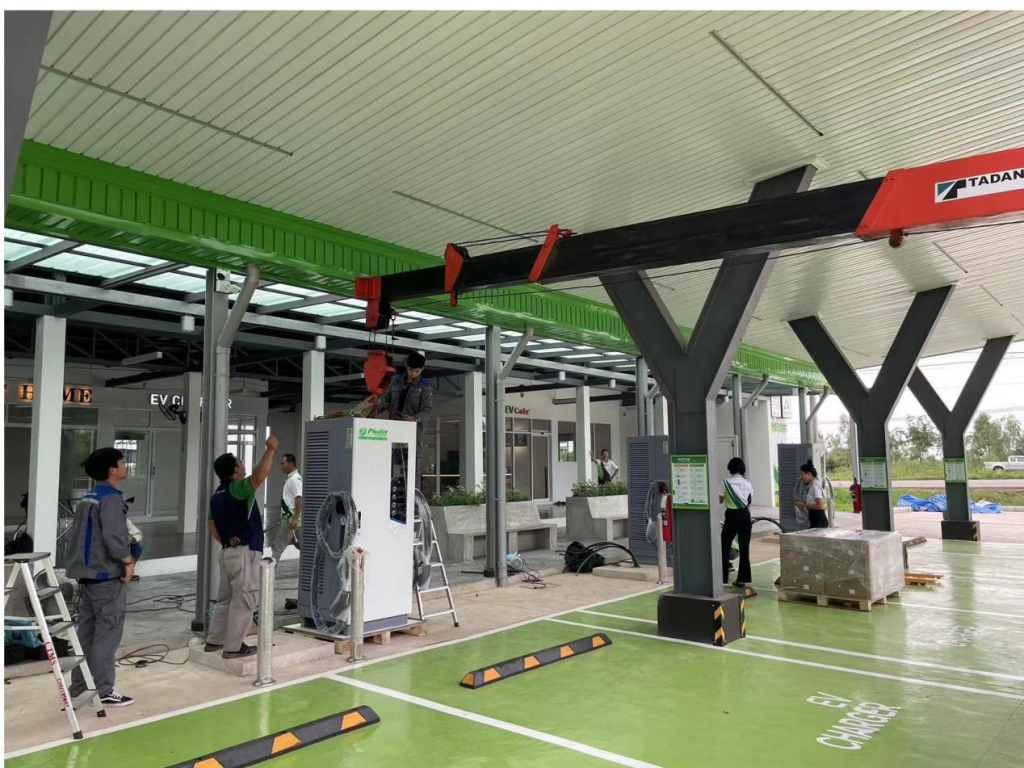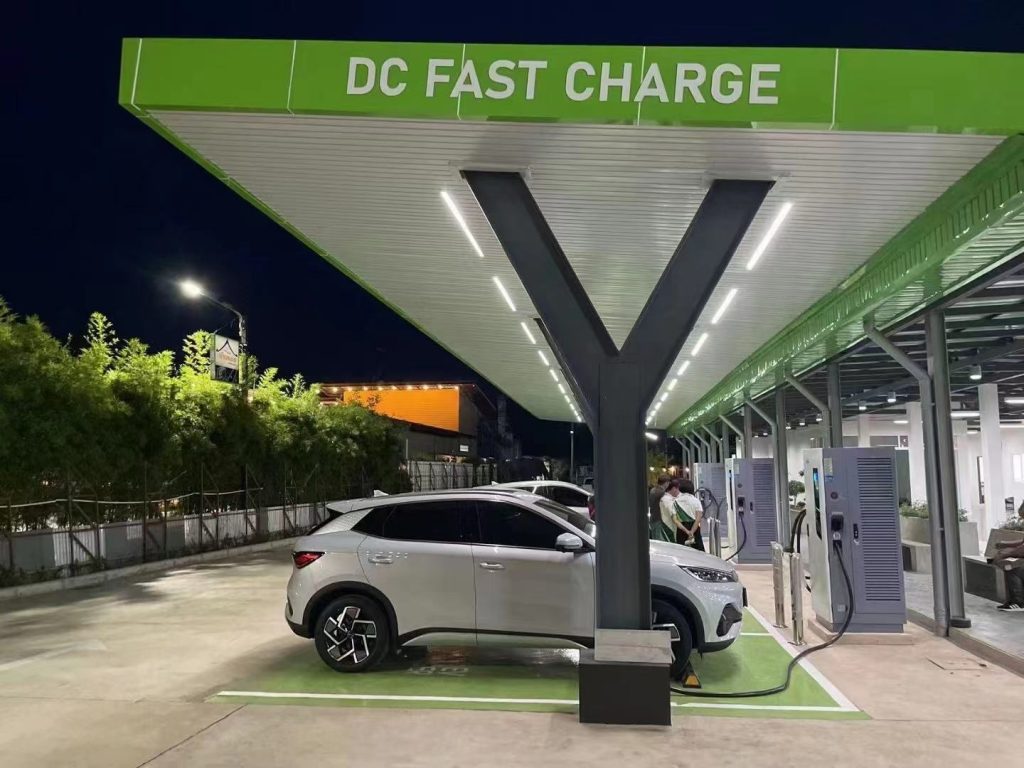
Products
Fast, Reliable, Everywhere

Solutions
Efficient, Innovative EV Charging Solutions.
News
We are committed to the innovation and application of EV charging.
As the global transition to electric vehicles (EVs) accelerates, the demand for convenient and efficient EV charging solutions is skyrocketing. Parking lots, both residential and commercial, are becoming critical locations for deploying EV charging infrastructure. This comprehensive guide explores the myriad of benefits associated with installing EV charging equipment in parking lots, the various application scenarios, and the key considerations for successful implementation. We delve into real-world case studies, examine the common challenges faced, and provide actionable insights to help you navigate the complexities of EV charger deployment in EV charging parking lots. Whether you're a property manager, business owner, or city planner, this guide is designed to equip you with the knowledge needed to make informed decisions about integrating EV charging solutions into your parking facilities.
The adoption of electric vehicles is reshaping the transportation landscape, and with it, the necessity for accessible charging infrastructure is more critical than ever. Parking lots present an ideal environment for deploying EV charging equipment due to their ubiquitous presence and ease of access for drivers. In this section, we will introduce the fundamental concepts of EV charging solutions and their importance in today's rapidly evolving automotive ecosystem. You'll gain a comprehensive understanding of how integrating EV chargers into parking lots can enhance user experience, increase revenue, and promote environmental sustainability. Additionally, we will outline the structure of this guide, which aims to provide you with a thorough roadmap for the successful implementation of EV charging equipment in various parking scenarios. From residential complexes to commercial hubs and public parking areas, each scenario presents unique opportunities and challenges that we will explore in detail.
The integration of EV charging solutions in parking lots is becoming increasingly vital as electric vehicles gain popularity worldwide. Parking lots serve as strategic locations for deploying charging infrastructure due to their accessibility and convenience for EV drivers. This section will delve into the multifaceted value that EV charging solutions bring to parking lots, highlighting their benefits from various perspectives. Whether it's enhancing the user experience, generating revenue, creating a competitive edge, or promoting environmental sustainability, EV charging solutionsare proving to be indispensable in modern parking facilities.
Enhancing user experience and convenience is a primary advantage of integrating EV charging solutions into parking lots. For EV owners, the availability of charging stations in parking lots means they can conveniently charge their vehicles while attending to their daily activities, such as shopping, working, or running errands. This seamless integration into their routine eliminates the need for special trips to dedicated charging stations, saving both time and effort.

Moreover, advanced EV charging solutions, like those offered by Pilot x Piwin, come equipped with user-friendly interfaces and smart features. These features include easy-to-use mobile apps for locating charging stations, real-time status updates, and remote monitoring and control. Drivers can effortlessly find available chargers, initiate and stop charging sessions, and even pay for the service through their smartphones, enhancing the overall convenience.
Furthermore, by providing reliable and fast DC charging options, parking lot operators can significantly reduce the waiting time for drivers. Quick and efficient charging ensures that EV owners can recharge their vehicles within a shorter time frame, making EVs more practical for long-distance travel and daily commuting. This improved user experience encourages more people to adopt electric vehicles, contributing to the growth of the EV market and the broader goal of reducing carbon emissions.
The deployment of EV charging solutions in parking lots presents a significant opportunity to boost revenue for property owners and operators. Here’s how these solutions can transform charging services into a lucrative revenue stream:
In summary, integrating EV charging solutions in parking lots not only meets the growing demand for EV infrastructure but also opens up multiple avenues for generating substantial revenue. By leveraging user fees, partnerships, advertising, government incentives, and enhanced property value, parking lot operators can significantly boost their revenue while supporting the transition to sustainable transportation.
Integrating EV charging solutions into parking lots offers distinct advantages that can significantly set a facility apart from its competitors. Here's how these solutions can create a competitive edge:

Providing EV charging stations demonstrates a commitment to sustainability and innovation. This enhances the property’s reputation, attracting environmentally conscious customers and businesses looking to align with green initiatives. As the number of electric vehicles on the road continues to grow, the availability of charging infrastructure becomes a critical factor in choosing parking facilities. By offering this amenity, parking lots can attract a loyal base of EV drivers.
The advanced technology in DC chargers, like those from Pilot x Piwin, ensures faster and more efficient charging. This not only meets the needs of EV drivers but also reduces wait times, enhancing user satisfaction. The convenience of quick charging can be a decisive factor for drivers choosing where to park and charge, giving facilities equipped with these chargers a competitive advantage.
Moreover, integrating smart features such as mobile app connectivity, real-time charger availability, and easy payment options makes the user experience seamless and modern. These conveniences appeal to tech-savvy customers and can significantly differentiate a parking lot from those without such features.
In summary, EV charging solutions not only fulfill a growing need but also enhance the overall attractiveness and competitiveness of parking facilities. By investing in these solutions, parking lot operators can set themselves apart as leaders in sustainability and customer convenience.
Deploying EV charging solutions in parking lots offers significant environmental benefits. As electric vehicles (EVs) become more prevalent, the need for accessible charging infrastructure grows. Here are the key green benefits:
Firstly, EV charging solutions help reduce greenhouse gas emissions. Traditional vehicles emit carbon dioxide and other pollutants, contributing to air pollution and climate change. In contrast, EVs produce zero tailpipe emissions. By facilitating the use of EVs, charging stations play a crucial role in lowering overall emissions.
Secondly, integrating EV chargers with renewable energy sources, such as solar or wind power, further enhances their environmental benefits. This reduces reliance on fossil fuels and supports a cleaner energy grid. For example, Pilot x Piwin’s chargers are designed to be compatible with various renewable energy sources, promoting sustainable energy use.
Lastly, EV charging infrastructure supports the broader adoption of electric vehicles, encouraging more people to switch from gasoline-powered cars to EVs. This shift not only reduces air pollution but also decreases noise pollution, especially in urban areas where traffic noise is a significant concern.
In summary, the green environmental benefits of EV charging solutions are substantial. They reduce greenhouse gas emissions, promote renewable energy use, and encourage the adoption of quieter, cleaner electric vehicles. By installing these solutions in parking lots, we can make a positive impact on the environment.
Electric vehicle (EV) charging solutions are becoming an essential feature in various parking lot settings as the demand for EV infrastructure grows. Different types of parking lots present unique opportunities and challenges for implementing EV chargers. This section explores the primary application scenarios for EV charging in parking lots, including residential, commercial, and public spaces. Understanding these scenarios helps stakeholders make informed decisions about the best practices for deploying and benefiting from EV charging infrastructure.
Implementing EV charging solutions in residential parking lots can greatly enhance the convenience and appeal of housing complexes. Here’s how to effectively implement and benefit from these installations:

Implementing EV charging solutions in commercial parking lots offers distinct benefits. These advantages not only cater to the needs of electric vehicle owners but also provide significant business value.
One key advantage is attracting a growing number of environmentally conscious customers. By providing EV chargers, commercial properties become more appealing to those who drive electric vehicles, increasing customer traffic and loyalty. This is particularly important for retail centers and office complexes where customer and employee satisfaction can drive business success.
Additionally, installing EV charging stations can enhance the property’s value. Commercial real estate with EV infrastructure is seen as forward-thinking and environmentally responsible, which can attract higher-quality tenants and potentially allow for higher lease rates.
Another benefit is the opportunity for increased revenue. As customers charge their vehicles, they tend to spend more time on-site, which can lead to higher sales in retail environments. Moreover, businesses can generate income through charging fees, creating a new revenue stream.
Lastly, integrating EV charging solutions aligns with corporate sustainability goals, showcasing a commitment to reducing carbon footprints and promoting green initiatives. This not only improves the company’s public image but can also attract partnerships and clientele who value sustainability.
In summary, commercial parking lots equipped with EV charging solutions offer enhanced customer attraction, increased property value, additional revenue opportunities, and strong support for sustainability initiatives.
To maximize accessibility and usage of EV charging solutions in public parking lots, a strategic and user-centric approach is essential.
Optimal Placement: Position chargers near entrances or high-traffic areas to enhance visibility and convenience. This encourages more drivers to use the facilities.
Variety of Chargers: Offering both fast DC chargers and slower AC chargers caters to different needs. Fast chargers are ideal for quick stops, while AC chargers serve those parked for longer durations.
Clear Signage: Ensure that signage directs drivers to EV charging spots effectively. Easy-to-follow instructions and multilingual support enhance user experience.
Payment Integration: Incorporate multiple payment methods, such as mobile apps, contactless payments, and subscription services, to make charging convenient for all users.
Regular Maintenance: Schedule regular maintenance checks to keep chargers operational. Reliable support increases user trust and repeat usage.
Promotion: Advertise the availability of chargers through local media and digital platforms. Highlight benefits like convenience and environmental impact to attract more users.
By implementing these strategies, public parking lots can enhance the accessibility and usage of EV charging solutions, supporting the growing number of EV drivers and promoting sustainability.
Installing EV charging equipment in parking lots involves several critical considerations to ensure a successful and efficient deployment. From evaluating the infrastructure and understanding regulatory requirements to analyzing costs and planning for maintenance, each step plays a vital role in creating a reliable and user-friendly charging network. Addressing these factors thoroughly will not only enhance user satisfaction but also maximize the return on investment and support sustainable transportation initiatives.
Evaluating parking lot infrastructure is the first crucial step in deploying EV charging equipment. Here's what to consider:
Electrical Capacity: Assess the existing electrical infrastructure to determine if it can support the additional load of EV chargers. This includes checking the capacity of transformers, distribution panels, and the overall power supply. Upgrading electrical systems might be necessary to handle the increased demand.
Space and Layout: Ensure there is adequate space to accommodate EV charging stations. Consider the layout to facilitate easy access for vehicles and prevent congestion. Designate specific parking spots for EVs, ideally close to power sources to minimize installation costs.
Accessibility: Make sure the charging stations are easily accessible to all users, including those with disabilities. This includes complying with local regulations regarding the placement and design of EV charging spots.
Infrastructure Integration: Determine how the new charging stations will integrate with existing infrastructure. This includes evaluating the impact on current parking operations and any potential disruptions during the installation phase.
Future-Proofing: Plan for future expansion by installing conduits and additional electrical capacity that can support more chargers as the demand for EV charging grows. This proactive approach can save costs and reduce downtime in the long run.
By carefully evaluating these aspects, you can ensure that your parking lot is well-prepared for the installation of EV charging equipment, providing a seamless and efficient experience for all users.
When installing EV charging equipment in parking lots, understanding regulatory and permitting requirements is crucial.
Firstly, ensure compliance with local building codes and standards, which cover aspects like electrical safety and zoning laws. Engaging with local authorities early helps streamline the permitting process, often involving detailed submissions of installation plans.
Accessibility is another key consideration. Charging stations must be accessible to all users, including those with disabilities, and meet specific design and placement criteria.
Additionally, coordinate with local utilities to manage electrical load requirements. This might involve infrastructure upgrades and negotiations for electricity rates.
Lastly, be aware of available incentives and rebates that can offset installation costs, promoting wider adoption of EV infrastructure. Navigating these regulatory and permitting landscapes effectively ensures a smooth and compliant installation process.

Evaluating the investment costs and benefits of installing EV charging equipment is crucial for ensuring a sound financial decision. Let's break down the key financial aspects:
Charging Fees:
Incentives/Grants: Varies by region, with potential one-time grants ranging from $1,000 to $5,000.
Increased Foot Traffic Revenue: Indirect benefit to nearby businesses.
| Category | Low Estimate ($) | High Estimate ($) |
| Initial Costs | ||
| Charging Equipment | 10,000 | 40,000 |
| Installation Costs | 3,500 | 8,000 |
| Infrastructure Upgrades | 1,500 | 4,500 |
| Total Initial Costs | 15,000 | 52,500 |
| Operating Costs (Annual) | ||
| Electricity | 1,200 | 3,600 |
| Maintenance | 500 | 1,500 |
| Software/Network Fees | 300 | 600 |
| Total Operating Costs (Annual) | 2,000 | 5,700 |
| Revenue Streams (Annual) | ||
| Charging Fees | 10,950 | 18,250 |
| Incentives/Grants | 1,000 (one-time) | 5,000 (one-time) |
| Increased Foot Traffic Revenue | Indirect | Indirect |
| Total Revenue (Annual) | 10,950 | 18,250 |
Payback Period:
ROI (Annual):
By understanding the detailed financial implications, investing in EV charging infrastructure can be a sound and profitable decision. The initial investment is balanced by steady revenue from charging fees and potential grants, along with indirect benefits such as increased foot traffic and enhanced brand reputation.
Ensuring the long-term reliability and efficiency of EV charging equipment requires diligent post-installation maintenance and support. Regular maintenance checks are crucial; scheduling routine inspections can help identify and address issues before they become major problems. It's also important to keep the charging stations clean and free from debris to ensure optimal performance.
Updating firmware and software regularly is another best practice, as it enhances functionality and security. Utilizing remote monitoring systems allows for real-time tracking and efficient troubleshooting of any issues that arise.
User support is also key. Providing clear instructions and support materials can help users navigate any problems they encounter. Additionally, having a responsive customer service team can significantly improve user satisfaction.
Analyzing usage data can guide future improvements. By understanding peak usage times and common issues, you can optimize the performance of your charging stations. Partnering with local electricians for timely repairs and working closely with manufacturers ensures you have the necessary support and parts for maintenance.
By following these best practices, you can ensure that your EV charging equipment remains reliable and efficient, providing a better experience for users and maximizing the return on your investment.
Deploying EV charging equipment in parking lots is a complex process that can present several challenges. From technical hurdles and infrastructure issues to user acceptance and integration concerns, each obstacle requires careful consideration and planning. Understanding these challenges and how to effectively address them is crucial for a successful deployment.
Overcoming technical hurdles in the deployment of EV charging equipment involves addressing both hardware and software challenges. Here are some key strategies to consider:
1.Compatibility and Standards
Ensure that the charging equipment is compatible with various EV models and adheres to industry standards. This includes considering different plug types, voltage requirements, and communication protocols.
2.Power Supply and Management
Assess the power supply capabilities of the parking lot. High-powered DC chargers require a stable and robust electrical infrastructure. Implement power management solutions to prevent overloads and ensure efficient energy distribution.
3.Site Assessment and Preparation
Conduct a thorough site assessment to identify potential issues such as inadequate electrical infrastructure, limited space, or environmental factors. Preparing the site adequately before installation can mitigate many technical problems.
4.Remote Monitoring and Diagnostics
Implement remote monitoring systems that allow for real-time diagnostics and troubleshooting. This enables quick identification and resolution of issues, minimizing downtime and maintenance costs.
5.Regular Maintenance and Updates
Establish a routine maintenance schedule to ensure all equipment remains in optimal condition. Regularly update the software to enhance performance, security, and compatibility with new EV models.
By proactively addressing these technical challenges, you can ensure a smoother deployment process and a more reliable EV charging infrastructure.
Deploying EV charging equipment in parking lots involves several infrastructure and integration challenges. One of the primary concerns is the existing electrical capacity, as many parking facilities may not support the high power demand of DC fast chargers. Upgrading the electrical infrastructure, including transformers and circuit breakers, is often necessary to ensure reliable and safe operation.
Space constraints and layout design are also critical, as limited space can restrict the number and placement of charging stations. An efficient layout that maximizes charging points while ensuring easy access for EV drivers is essential. Additionally, integrating new EV charging stations with existing parking management and payment systems can be complex, requiring compatibility with various software and hardware systems.
Reliable network connectivity is crucial for the operation of EV charging stations, ensuring seamless communication between charging units, backend systems, and user interfaces. Planning for future expansion is also vital, as the infrastructure should be scalable to accommodate more charging stations as EV adoption grows. Addressing these issues proactively can lead to a more efficient and user-friendly deployment of EV charging equipment.
User acceptance and usage habits are crucial factors in the successful deployment of EV charging equipment in parking lots. To address these issues, it is essential to focus on education, convenience, and engagement.
Firstly, educating potential users about the benefits and ease of use of EV chargers is key. This can be achieved through informational campaigns, demonstrations, and user guides. Providing clear instructions and customer support can significantly enhance user confidence and willingness to adopt the new technology.
Convenience is another critical aspect. Ensuring that charging stations are easily accessible and integrated with popular parking lots can encourage usage. Features such as multiple payment options, user-friendly interfaces, and real-time availability updates can make the charging experience more convenient and appealing.
Engaging with the community and gathering feedback can also help in addressing user acceptance. By understanding user preferences and concerns, adjustments can be made to improve the overall experience. Offering incentives such as loyalty programs or discounts for frequent users can further promote positive usage habits.
By focusing on education, convenience, and engagement, you can effectively address user acceptance and foster positive usage habits, ensuring the successful integration of EV charging equipment in parking lots.
Deploying EV charging equipment in parking lots presents a comprehensive approach to addressing the growing demand for electric vehicle infrastructure. By understanding the value of EV charging solutions, considering the various application scenarios, and addressing the key considerations and challenges, businesses and property owners can effectively implement and benefit from this technology. The integration of EV chargers not only enhances user experience and boosts revenue but also contributes to environmental sustainability and creates a competitive edge. With proper planning, investment, and support, the deployment of EV charging equipment can be a significant step towards a greener and more efficient future.
